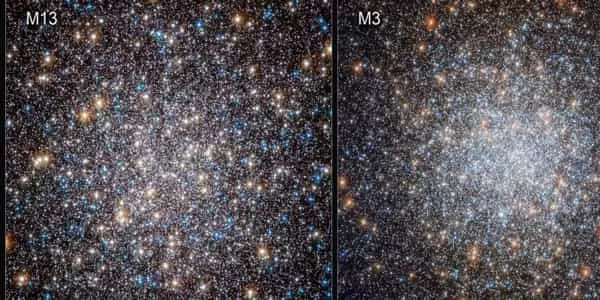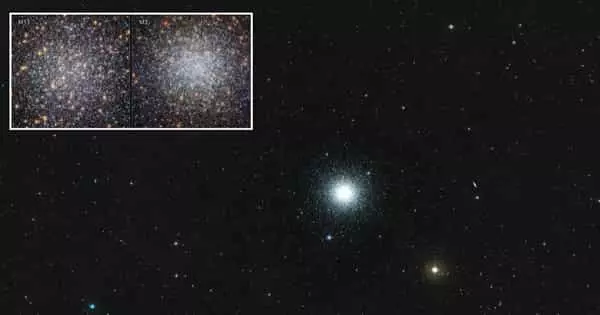Could dying celebrities hold the key to looking younger? New evidence suggests that white dwarfs may continue to burn hydrogen in their final stages of life, making them appear younger than they are. This discovery may have ramifications for how astronomers calculate the ages of star clusters.
Observations from the NASA/ESA Hubble Space Telescope have called into question the widely held belief that white dwarfs are inert, slowly cooling stars. An international team of astronomers has discovered the first evidence that white dwarf stars can slow their aging by burning hydrogen on their surfaces.
“We have discovered the first observational evidence that white dwarfs can still undergo stable thermonuclear activity,” Jianxing Chen of the Alma Mater Studiorum Università di Bologna and the Italian National Institute for Astrophysics, who led this research, said. “This came as quite a surprise because it contradicts the popular belief.”
White dwarfs are slowly cooling stars that have shed their outer layers during their final stages of life. They are common in the universe; roughly 98 percent of all-stars, including our Sun, will eventually end up as white dwarfs [note 1]. The study of these cooling stages aids astronomers in understanding not only white dwarfs but also their earlier stages.
New evidence suggests that white dwarfs could continue to burn hydrogen in the final stages of their lives, causing them to appear more youthful than they actually are.
Cooling white dwarfs in two massive collections of stars, the globular clusters M3 and M13, were compared to investigate the physics underlying white dwarf evolution [Note 2]. Many physical properties, such as age and metallicity [Note 3], are shared by these two clusters, but the populations of stars that will eventually give rise to white dwarfs are distinct. The overall color of stars at an evolutionary stage known as the Horizontal Branch, in particular, is bluer in M13, indicating a population of hotter stars. This makes M3 and M13 an ideal natural laboratory for studying how different populations of white dwarfs cool.
“The excellent quality of our Hubble observations provided us with a comprehensive view of the stellar populations of the two globular clusters,” Chen continued. “We were able to compare how stars evolve in M3 and M13 as a result of this.”

The team observed M3 and M13 at near-ultraviolet wavelengths with Hubble’s Wide Field Camera 3, allowing them to compare over 700 white dwarfs in the two clusters. They discovered that M3 contains standard white dwarfs, which are simply stellar cores cooling. M13, on the other hand, is home to two populations of white dwarfs: standard white dwarfs and those that have managed to retain an outer envelope of hydrogen, allowing them to burn for longer and thus cool more slowly.
When the researchers compared their findings to computer simulations of stellar evolution in M13, they discovered that roughly 70% of the white dwarfs in M13 are burning hydrogen on their surfaces, slowing the rate at which they cool.
This discovery may have ramifications for how astronomers calculate the ages of stars in the Milky Way. White dwarf evolution has previously been modeled as a predictable cooling process. Because of this simple relationship between age and temperature, astronomers have used the white dwarf cooling rate as a natural clock to calculate the ages of star clusters, particularly globular and open clusters. However, white dwarfs burning hydrogen could cause these age estimates to be up to a billion years off.
“Our discovery challenges the definition of white dwarfs as we consider a new perspective on how stars age,” said Francesco Ferraro, who coordinated the study at the Alma Mater Studiorum Università di Bologna and the Italian National Institute for Astrophysics. “We are now looking into other clusters like M13 to further constrain the conditions that drive stars to keep the thin hydrogen envelope that allows them to age slowly.”
Notes
[Note 1] Formal paraphrase The Sun is only 4.6 billion years into its estimated 10-billion-year lifespan. When the Sun’s core runs out of hydrogen, it will swell into a red giant, engulfing the inner planets and searing the Earth’s surface. It will then shed its outer layers, leaving the exposed core of the Sun as a slowly cooling white dwarf. This stellar ember will be extremely dense, packing a significant portion of the Sun’s mass into a roughly Earth-sized sphere.
[Note No. 2] M3 is a star cluster with approximately 500,000 stars in the constellation Canes Venatici. M13, also known as the Great Globular Cluster in Hercules, has a slightly smaller number of stars, only a few hundred thousand. Because white dwarfs are frequently used to estimate the ages of globular clusters, Hubble has spent a significant amount of time exploring white dwarfs in old and densely populated globular clusters. In 2006, Hubble made the first direct observation of white dwarfs in globular star clusters.
[Note No. 3] The term “metallicity” is used by astronomers to describe the proportion of a star that is made up of elements other than hydrogen and helium. The vast majority of matter in the Universe is either hydrogen or helium; for example, the Sun’s mass is 74.9 percent hydrogen, 23.8 percent helium, and the remaining 1.3 percent is a mixture of all the other elements, which astronomers refer to as “metals.”
















